
Lilium is a genus of herbaceous flowering plants growing from bulbs, all with large prominent flowers. They are the true lilies. Lilies are a group of flowering plants which are important in culture and literature in much of the world. Most species are native to the temperate northern hemisphere, though their range extends into the northern subtropics. Many other plants have "lily" in their common names, but do not belong to the same genus and are therefore not true lilies.

Lilium martagon, the martagon lily or Turk's cap lily, is a Eurasian species of lily. It has a widespread native region extending from Portugal east through Europe and Asia as far east as Mongolia.

Lilium henryi, sometimes called tiger lily or Henry's lily, is a native lily of the mountains of central China. The flowers are orange, spotted black, and unscented. The petals are recurving, and eventually resemble those of the more widespread Turk's-cap lily.

Lilium speciosum is an East Asian species of plants in the lily family. It is native to southern Japan and southern China, where it can be found at elevations of 600–900 metres (2,000–3,000 ft). It is sometimes called the Japanese lily though there are other species with this common name.
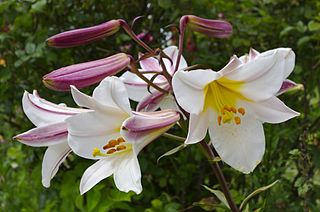
Lilium regale, called the regal lily, royal lily, king's lily, or, in New Zealand, the Christmas lily, is a species of flowering plant in the lily family Liliaceae, with trumpet-shaped flowers. It is native to the western part of Sichuan Province in southwestern China, and cultivated elsewhere as an ornamental. It was introduced to England in 1903 by Ernest Henry Wilson.
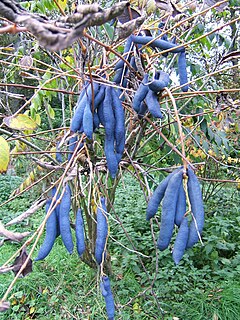
Decaisnea Hook.f &Thomson, known commonly as dead man's fingers, blue bean plant or blue sausage fruit, is a genus of flowering plant in the family Lardizabalaceae. It is native to eastern Asia, from China west to Nepal and south to Myanmar.

Lilium michauxii, commonly known as the Carolina lily, can be found in the southeastern United States from southern Virginia in the north to the Florida Panhandle in the south to eastern Texas in the west. It is most common in July and August but can be found blooming as late as October. It was named for the French botanist André Michaux, who traveled and did extensive research throughout the Southeast.

Lilium nepalense, the lily of Nepal, is an Asian plant species in the lily family. It is native to the Himalayas and nearby regions: northern Thailand, northern Myanmar, Assam, Bhutan, Sikkim, Nepal, Uttarakhand, Tibet, and Yunnan. It can be found growing on wet forest borders at 1,200 to 3,000 m.
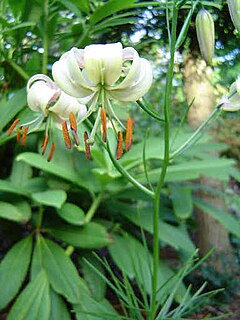
Lilium cernuum is a species of lily native to Korea, the Primorye region of Russia, and northeastern China.

Lilium pensylvanicum is an Asian plant species of the family Liliaceae. Sometimes called the Siberian lily, it is native to a cold climate and needs frost in the winter. It is found in the wild form in Siberia, the Russian Far East, Mongolia, northeast China, Korea and Hokkaidō.

Lilium tsingtauense, also known as twilight lily, is an East Asian species of plants in the lily family. It is native to Korea and eastern China.

Lilium distichum is an Asian species herbaceous plant of the lily family which is native to northeastern China, Korea, and eastern Russia.
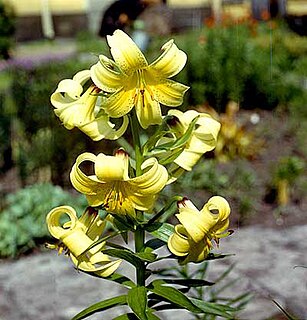
Lilium kesselringianum is a large herbaceous member of the lily family. It is native to North and South Caucasus as well as northern Turkey. It grows from sea level along the Black Sea up into the mountains to subalpine level on forest edges, in brushlands, and in grassy meadows.

Quercus franchetii, commonly known as the zhui lian li evergreen oak, is a species of oak in the section Quercus sect. Cerris, native to a wide area of eastern Asia. It is an oak native of China, northern Thailand and Vietnam where it grows at an altitude between 800 and 2600 meters.

Lilium concolor is a species of flowering plant in the lily family which occurs naturally in China, Japan, Korea and Russia. Its relationship with other species is not clear, although it has some similarities to Lilium pumilum.

Allium cyathophorum is a Chinese species of flowering plant in the onion genus Allium of the family Amaryllidaceae. It grows at elevations from 2700 metres up to 4600 metres.
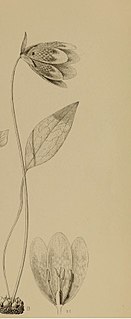
Fritillaria davidii is an Asian species of herbaceous plant in the lily family, native to Sichuan Province in China.

Decaisnea fargesii, the blue sausage fruit, blue bean shrub or dead men's fingers, is a member of the family Lardizabalaceae, and is native to Nepal, Tibet and China. It is a deciduous shrub which grows to 4 m tall and broad, but may achieve 8 m (26 ft) eventually.

Lilium brownii var. viridulum is a variety of Lilium brownii native to China.

Primula amethystina is a species of flowering plant in the family Primulaceae, native to China. The plant is commonly found in west and northwest Yunnan and southwest Sichuan, and across the border in Tibet. It typically grows best in wet, boggy soil.



















